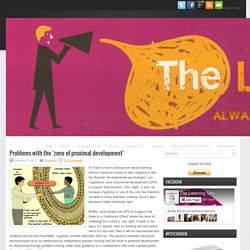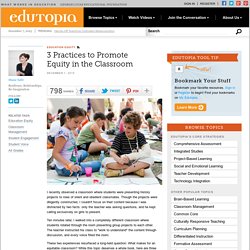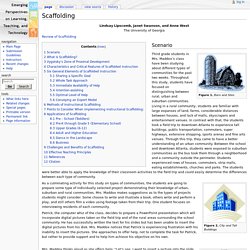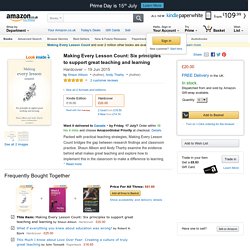

Problems with the ‘zone of proximal development’ Wertsch (1984) suggested that if this theoretical construct was not elaborated further, then there was a risk that “it will be used loosely and indiscriminately, thereby becoming so amorphous that it loses all explanatory power” (p. 7).

Mercer and Fisher (1992) believe that “there is a danger that the term is used as little more than a fashionable alternative to Piagetian terminology or the concept of IQ for describing individual differences in attainment or potential” (p. 342). Palinscar (1998) suggests that in the context of research about the negotiated nature of teaching and learning it is “probably one of the most used and least understood constructs to appear in contemporary educational literature” (p. 370). (Chaiklin p. 2) Clearly, there’s a common sense aspect appeal.
In order to understand the problems with the way ZPD is applied in educational contexts we need to critique each of the three assumptions in turn. The generality assumption The assistance assumption. Marking in Perspective: Selective, Formative, Effective, Reflective. Marking in Perspective: Selective, Formative, Effective, Reflective Context and Motivation I’m feeling relieved, smug and virtuous because I’ve just marked some books.

12 Pointers Towards Great Teaching Assessment and Learning. Twelve is a good a number as any for directing people towards better teaching, assessment and learning.

It certainly won’t cover everything and there are probably things you will disagree with. I don’t have any monopoly on what might improve teaching, assessment and learning. Modul 2.4 Begreppskarta. The science of learning: five classic studies. A few classic studies help to define the way we think about the science of learning.

A classic study isn’t classic just because it uncovered a new fact, but because it neatly demonstrates a profound truth about how we learn – often at the same time showing up our unjustified assumptions about how our minds work. A classic study defines where research will go next – whether to confirm, disprove or qualify the original finding – and helps us to reorganise our learning to be more effective. I’m a psychologist, so you won’t be surprised that my choice of classic studies concern the mental processes rather than the social processes involved in learning. Other people might pick a different five studies, but these are mine. Resources%5CFiveDirectInstruct. 3 Practices to Promote Equity in the Classroom. I recently observed a classroom where students were presenting history projects to rows of silent and obedient classmates.

Though the projects were diligently constructed, I couldn't focus on their content because I was distracted by two facts: only the teacher was asking questions, and he kept calling exclusively on girls to present. Ten minutes later, I walked into a completely different classroom where students rotated through the room presenting group projects to each other. The teacher instructed his class to "work to understand" the content through discussion, and every voice filled the room. These two experiences resurfaced a long-held question: What makes for an equitable classroom? While this topic deserves a whole book, here are three simple practices that you can try on to increase the range and frequency of student voices in your classroom. Glogin?URI= Improving peer feedback with Public Critique.
So, how much of the feedback students get do you think comes from their peers?

I’m not talking about feedback on their choice of trainers or on their ability to wear a hoodie with dash and élan, I’m talking about classroom feedback on their learning. So, go on; how much? Didaktorn: Språklärare utan språk. 10 creative alternatives to research reports and papers. Research reports and papers have been around a long time.

They haven’t evolved much. Scaffolding. Lindsay Lipscomb, Janet Swanson, and Anne West The University of Georgia Review of Scaffolding Scenario Figure 1.

Barn and Silos Third grade students in Mrs. Figure 2. Turn talk overview. Cult of Pedagogy. Making Every Lesson Count: Six principles to support great teaching and learning: Amazon.co.uk: Shaun Allison, Andy Tharby: Books. Trade in your item Get a £8.83Gift Card.

Flip to back Flip to front Listen Playing... Paused You're listening to a sample of the Audible audio edition. Learn more. 10READERizers.pdf. Plot Worksheets. SD_Lektionstips_insandare.pdf. Om verklighetsbaserat lärande. Verklighetsbaserat lärande är vår pedagogik som står till grund för vår skola.

20 Ways To Get A Noisy Classroom's Attention. 20 Ways To Get A Noisy Classroom’s Attention by Terry Heick Okay, so this isn’t about rethinking teaching and learning in a connected world, but that doesn’t change the fact that for many of you, simply beginning class can be the most challenging thing you do all day. It’s not easy. Www.christina.k12.de.us/literacylinks/elemresources/comprehension/techniques.pdf.
Educational Leadership:Students Who Challenge Us:The Many Uses of Exit Slips. What Makes a Question Essential? Parlör för pedagogproffs – vilka ord ska man använda och vilka ska undvikas? Dags att ta nya tag och komma igång med undervisning, rutiner, kollegialt samarbete och lärande. 5 techniques for questioning in your classroom. Published on December 15th, 2013 | by Mark Anderson I’m a big fan of Twitter – short messages, getting your point across succinctly… with that in mind, I’m going to keep this post short and sweet. Just five tried and tested techniques to assist with questioning in your classroom. One of the features of an outstanding classroom is one where students are challenged, stretched and not allowed to rest on their laurels. One way we can do that is through decent questioning and here are 5 elements that you might like to have in your teaching tool kit. 1. Frågebatteri.
Listening. Practicing Effective Questioning There are many ways to ask a question and some ways are better than others. Go.hrw.com/resources/go_sc/gen/HSTPR034.PDF. Many, Many Examples Of Essential Questions. Many, Many Examples Of Essential Questions by Terry Heick Essential questions are, ask Grant Wiggins defines, “‘essential’ in the sense of signaling genuine, important and necessarily-ongoing inquiries.”
These are grapple-worthy, substantive questions that not only require wrestling with, but are worth wrestling with–that could lead students to some critical insight in a 40/40/40-rule sense of the term. I collected the following set of questions through the course of creating units of study, most of them from the Greece Central School District in New York. In revisiting them recently, I noticed that quite a few of them were closed/yes or no questions, so I went back and revised some of them, and added a few new ones, something I’ll try to do from time to time.
En lektion om konsten att bygga en historia - Två pedagoger - ett klassrum. Diskussionsunderlag-bild. Studiedagen-del-2.pdf. TeachThought. To Teach Effective Writing, Model Effective Writing. I strive to teach my high school students the value of criticism, especially when it comes to improving their writing. To do so, I model how criticism continues to help me become a better writer. Earlier this year, for example, I shared a draft of one of my education feature articles, which included detailed feedback from an editor at a prominent media company. I asked my classes for advice on how to address several edits, dealing with sources, transitions, terminology, and structure. 8 Practical Strategies to Ge to Know Your Students. August 23, 2014 As a teacher, the first week of the new school year is always an exciting time for me as I get to deal with new classes and new students.There is always that deep-seated drive to know your students and learn about their learning styles, their previous academic background and what they expect from your class.
Each teacher has her/his own strategy to get to know their students but now with the widespread of technology, a number of digital activities can be used to enable students to express themselves freely and articulate what they want others to know about them. Creating autobiographical trailers, audio clips, blog postings..etc are some examples of how students can use technology to introduce themselves to their peers and to their learning community.
There are also a set of other interesting strategies that are not necessarily technology based and which teachers can use to get to know their students. The handy visual below features some of them . 2-Ready, set, group! Student Response Cards - The Teacher Toolkit. Stop and Jot - The Teacher Toolkit. Popsicle Sticks - The Teacher Toolkit. One Minute Sentence - The Teacher Toolkit. Jigsaw - The Teacher Toolkit. Guided Notes - The Teacher Toolkit. AH_maps.pdf. Exit Ticket - The Teacher Toolkit. Entry Ticket - The Teacher Toolkit. Card Sort - The Teacher Toolkit. Classroom Contract - The Teacher Toolkit. Attention Signal - The Teacher Toolkit. 3-2-1 - The Teacher Toolkit. Printed from. 3-2-1 - The Teacher Toolkit. Turn and Talk - The Teacher Toolkit. Lgr11-poesi för att tydliggöra mål, förväntningar och att bli ägare av sin egen inlärning.
Psykologilexikon - lexikon - ordbok i psykologi - hitta förklaringen till ordet här. Eng: Socratic question [sɒˈkrætɪk ˈkwestʃən, səʊˈkrætɪk ˈkwestʃən]. Fråga av den typ som används i sokratisk frågeteknik (eng: Socratic questioning, Socratic questioning technique), sokratisk samtalsstil, sokratisk metod (eng: Socratic method, Socratic dialogue, method of elenchus, elenctic method, Socratic irony), uppkallad efter den grekiske filosofen Sokrates (470-399 f Kr). Top 10 Tech Tips For Teachers. A Must Have Questioning Toolkit for Teachers and Educators. Questioning Toolkit. Essential Questions These are questions which touch our hearts and souls. 50 Ways To Challenge Yourself As A Teacher. Studiedagen-del-2. DBQ Design Assignment. I. Story Map. The Story Map interactive includes a set of graphic organizers designed to assist teachers and students in prewriting and postreading activities.
The organizers are intended to focus on the key elements of character, setting, conflict, and resolution development. Students can develop multiple characters, for example, in preparation for writing their own fiction, or they may reflect on and further develop characters from stories they have read. After completing individual sections or the entire organizer, students have the ability to print out their final versions for feedback and assessment. The versatility of this tool allows it to be used in multiple contexts. Förstelärare i Svedala. Jag har ibland undrat var slöjdprocessen slutar. Utveckling. The #5MinBehaviourPlan by @LeadingLearner and. Mikrolektioner ger effekt i Umeå. Flippfilm inför min föreläsning. A 4-Step Guide To Effective Lesson Planning. CL-1: Field-tested Learning Assessment Guide (FLAG): CATs: Concept Mapping.
5 Course Evaluation Templates To Help Your Students Grade You For A Change. SETT 2014 Patricia Diaz. Six Scaffolding Strategies to Use with Your Students. 7 proven strategies that WILL help you engage your students. Becoming Invisible In My Classroom. A Great Poster on The 6 Questions Critical Thinker Asks. World Café Method.